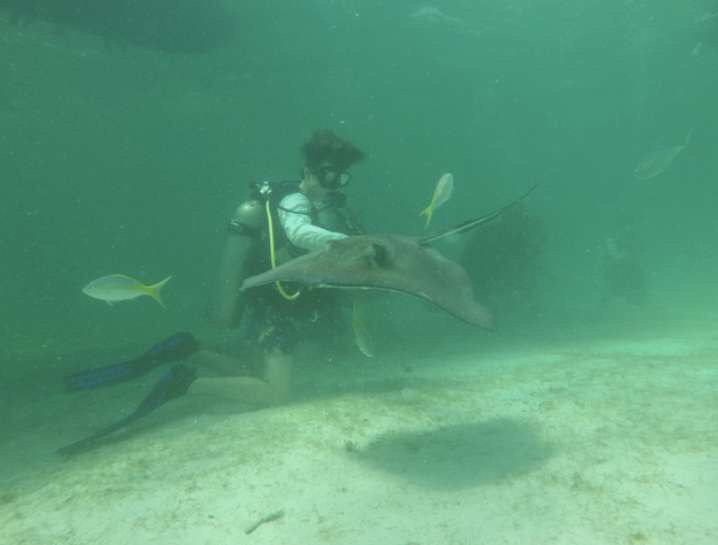In a stunning change of pace, the Jesuit Marine Biology Class wakes up at 7:00 A.M. ready to go and lively as ever (Just kidding, everyone slowly ate breakfast, sleepy from the dives earlier in the week). After breakfast, we climbed aboard the good old Twin Sister and made the half hour boat ride to our first dive site, Hepp’s Pipeline. At Hepp’s Pipeline, we went to a depth 80ft and saw the usual fish such as the stoplight parrotfish and schools of blue fish. Common small fish like these are important to the coral reef as they keep the food chain in check; however, as the coral reefs disappear due to human pollution so do these common fish and therefore they affect the larger fish that humans enjoy eating. In addition to the usual fish, we saw a spotted moray eel tucked away in the coral. Spotted moray eels can be difficult to see as they are normally tucked behind rocks and coral waiting for unsuspecting fish to wander into their trap. Eels are not the only marine life to stage traps for unsuspecting prey. For example, at Hepp’s Pipeline my dive partner and friend Aidan Patrick Hoofard pointed out a trumpetfish, which blends into the seaweed and waits for smaller prey to wander near them. After surfacing from Hepp’s Pipeline, we took a 45 minute break on the boat and were off to our next dive site, Spanish Bay. Spanish Bay earns its name as it’s near the ruins of the Spanish Resort which was destroyed by hurricane Ivan in 2004. Once we were in the water at Spanish Bay, our depth was 60ft and we saw many unique fish such the spotted drum fish, scorpionfish, a barracuda, and 3 lionfish. Drum fish are easily identified by their long wispy tails and timid behavior. They are normally seen with other drum fish in schools. Similar to eels and truly, scorpionfish are experts of camouflage and will sit for hours waiting for prey to wander too close then use their lighting fast reflexes to swiftly eat the smaller fish. They are very difficult to spot in the wild as they are normally perfectly camouflaged but they can be distinguished due to their large spines and wide mouths. While swimming back to the boat, our group also saw a large barracuda waiting in the open ocean for a meal. Barracuda have elongated silvery bodies with large teeth. In addition to these fish, we saw 3 lionfish, the invasive species of fish that are plaguing the world. We later surfaced and climbed aboard the boat to go back to the resort for lunch. After lunch we boarded the boat for the second time today and left for our third dive of the day the famous Stingray City. At Stingray City, we were 12ft deep and our dive masters, Bernie and Lucy, attracted about 6 stingrays over to our position using squid bait. We sat still on the ocean floor watching the stingrays glide through the water and eat the squid bait. Amongst the stingrays, we saw hogfish and goatfish who attempted to steal the squid bait but failed. Hogfish have long snouts and are white with red fins. Goatfish swim near the bottom of the sand and have “whiskers” that glide along the sand and look for shells that they eat. We watched the stingrays eat squid for about half an hour and were able to pet and feel the stingrays. Afterwards we surfaced and went back to the boat which took us to the resort for some rest and relaxation. A few of us relaxed by the pool and waited for dinner. We ate tortellini with shrimp for dinner and had ice cream for dessert. I can’t wait for the shipwreck dive tomorrow!


